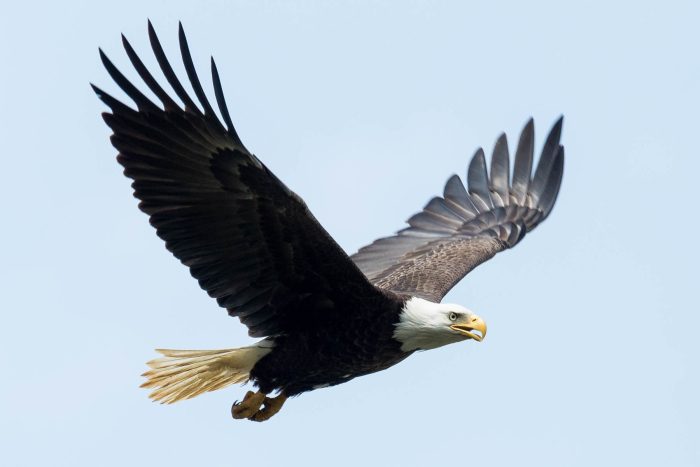Bald Eagle
Haliaeetus leucocephalus
The bald eagle is a large raptor with a yellow, hook-shaped bill and a white head and tail. It lives in forested, sparsely developed areas near rivers, wetlands and other waterways throughout the Chesapeake Bay watershed.
This section shows one large critter image at a time. Use the thumbnails that follow to select a specific image to display here.

This gallery contains a grid of small thumbnails. Selecting a thumbnail will change the main image in the preceding section.
Appearance
Bald eagles grow 30 to 40 inches in length with a wingspan of up to seven feet. They have a white head and tail, a dark brown body and a massive yellow, hook-shaped bill. Their feathers only reach halfway down their legs, leaving their ankles "naked." Their yellow feet have long claws, called talons. Immature bald eagles (less than five years old) are mottled brownish all over, and lack the white head and tail of adults.
Feeding
Bald eagles eat mostly fish, but will also prey upon waterfowl and small mammals, especially in winter. They hunt by perching atop a tree to look for prey, then swooping down and grasping prey in their talons. They will often scavenge for food by stealing prey from other birds or eating garbage or carrion (the decaying flesh of dead animals).
Predators
Bald eagles do not have any major predators.
Flight
Wings are held flat and straight while flying.
Voice
Eagles makes a sharp, cackling kleek-kik-ik-ik-ik or a lower kak-kak-kak.
Reproduction and life cycle
The largest breeding populations in the Chesapeake region are located in Dorchester County, Maryland, and along the James, Potomac and Rappahannock rivers. Bald eagles raised in the Bay region usually stay here their entire lives, as long as they have access to water. Males and females go through an unusual courtship ritual. While flying, they lock their talons together and then tumble toward the ground, breaking apart just before they reach the water. Eagle pairs usually build and repair their nests in early winter. Nests are made of large sticks and located near the top of mature trees close to water. Bald eagle nests are some of the largest nests in the world, weighing up to two tons.
Females lay one to three eggs (usually two) in January-March. She incubates them for 5 to 6 weeks, and they usually hatch a day or two apart. If a female lays three eggs and all three hatch, the youngest chick usually does not survive because it cannot compete with its older siblings for food. Chicks typically fledge at 10 to 12 weeks old, sometime between May and July. They still rely on their parents for several weeks after their first flight.
From approximately one to four years old, bald eagles are considered “immature” and have different coloring than adults. Immature eagles do not establish a breeding territory, instead moving throughout the region in search of food. Bald eagles can live as long as 28 years in the wild.
Did you know?
- The bald eagle is the national emblem of the United States.
- Bald eagles can be confused with ospreys and vultures. You can distinguish a bald eagle by its pure white head and tail, and its “naked” ankles.
- Bald eagle populations have slowly recovered since the middle of the 20th century, when use of the pesticide DDT caused the species to decline. In 2007, the U.S. Fish and Wildlife Service removed the bald eagle from the federal list of threatened and endangered species. By 2020, more than 3,000 breeding pairs of bald eagles were found on the Chesapeake Bay.
- Some bald eagles have been known to play with plastic bottles, sticks or other objects as toys, tossing them to one another in midair.
Sources and additional information
- Life in the Chesapeake Bay by Alice Jane Lippson and Robert L. Lippson
- Chesapeake Bay: Nature of the Estuary, A Field Guide by Christopher P. White
- Animal Diversity Web: Haliaeetus leucocephalus – University of Michigan Museum of Zoology
- All About Birds: Bald Eagle – The Cornell Lab of Ornithology
- NatureWorks: Bald Eagle – New Hampshire Public Television
